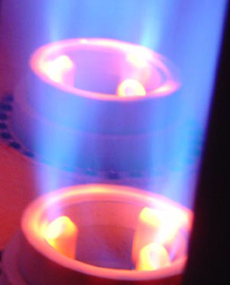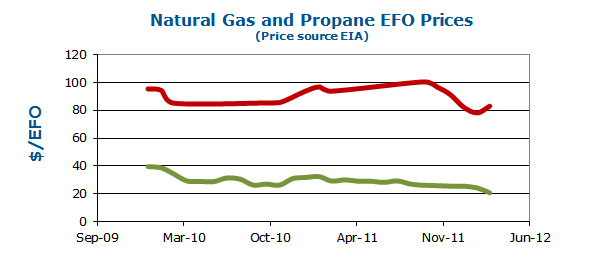RL Blogs

By Patrick the Process Engineer
Jun 24, 2012One of the biggest profit opportunities refineries have is avoiding the downgrade of propane and butane to refinery furnace fuel. Burning LPG instead of natural gas can cost several million dollars a year, so let's review why. |
||
| In most oil refineries a great deal of attention is focused on producing gasoline, jet, and diesel...the sexy products. However, careless separation control of refinery gas recovery units can lead to significant lost profit when refiners burn propane and butane instead of natural gas in the refinery furnaces.
sources for a refinery furnace as either natural gas (purchased from a local utility) or refinery process gas (produced inside the refinery).
The purchased natural gas is primarily made up of methane and light components. Generally, it’s a by-product of crude oil production. As discussed in a prior blog, cheap natural gas is providing a competitive advantage for U.S. refineries.
Refinery furnaces also burn refinery process gas. Process gas is a mixture of all the light vapor by-products of various processing units. Most process units have sat gas unit which separates the light gases for further sales. Often the remaining product (methane and ethane) from the gas recovery unit is sent to the refinery process gas pool for burning in refinery furnaces. These refineries sat gas units are the last separation step between converting molecules from product sales to furnace feed.
If sat gas unit separation process is poor this often translates to propane and butane getting into the refinery process gas system. But why would this matter, everyone knows that propane and butane are the lowest value products in a refinery?
It matters because propane and butane have significant value compared to natural gas, five times more value when compared on equivalent fuel oil (EFO) basis. This can translate to serious lost dollars (or burned dollars) if a refinery gets careless with their sat gas unit separation and furnace feed sources.
In order to truly understand the opportunity, it’s good to perform the simple calculations to see the math work out.
First, lets get natural gas on a dollar per equivalent fuel oil basis ($/EFO). The simplicity of EFO is that it allows us to compare gases and liquids on a similar energy basis. The natural gas price is often quoted in dollars per million standard cubic feet ($/MSCF) or dollars per million British thermal unit ($/MMBTU). In order to convert natural gas from $/MSCF to $/EFO one just needs a simple unit conversion.
Once the simple equation is understood, its easy to apply the price of natural gas to the constant 0.2 EFO/MSCF to get a natural gas EFO price. For instance the March 2012 natural gas price reported by EIA was $3.60/MSCF. This converts natural gas to an EFO value of $18/EFO.
Now, if you want to understand the penalty for burning propane or butane in refinery furnace versus natural gas it's simply a matter of converting propane or butane to an $/EFO barrel to understand the cost comparison.
Converting propane to an EFO basis is no trickier than natural gas, but it just requires a slightly different conversion process. Propane is often quoted in dollars per gallon so converting to a dollar per EFO basis requires the conversion propane gallons to EFO. Since EFO is a function of equivalent energy every molecule has a different gallon to EFO constant (propane is 0.015 EFO per gallon.)
EIA reported that the average U.S. propane price in March 2012 was $1.26 per gallon. Using the previous calculation that propane cost per EFO ($/EFO) is $84/EFO.
So for the same EFO value propane is five times more expensive than natural gas. Put in these simple terms would make every refinery operator and engineer think twice about letting those propane and butane molecules slip into to the refinery process gas streams. Today's market is no different than the past several years as seen in the data from EIA.
The simple analysis can be repeated for butane by just using current price of butane and the butane EFO/gallon conversion factor of 0.017. The butane cost can also be greatly magnified during winter when butane’s value for gasoline blending often quadruples. | ||
|











